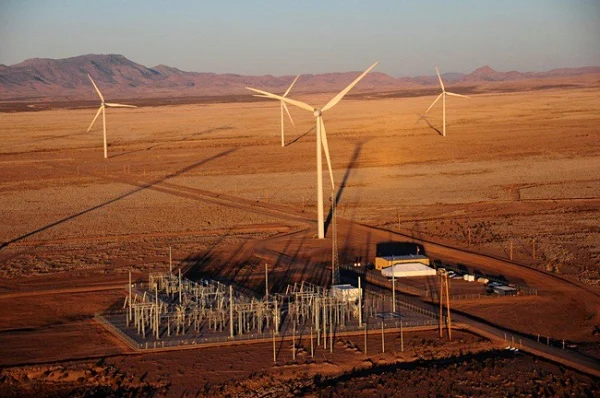Construction of a big New Mexico array that will provide some of the cheapest electricity ever under contract from solar photovoltaics is “well underway” and expected to be completed in May, according to the state’s land commissioner.
First Solar is building the Macho Springs plant, which became something of a cause célèbre in energy circles when the power purchase agreement price with El Paso Electric was disclosed to be $57.90 per megawatt-hour – as Greentech Media reported, “a low number, close to the price of an existing coal plant, and seemingly half of what has typically been paid for projects of this nature.”

Macho Springs wind and substation (image via UniSource Energy Services)
The Macho Springs project was noticed by researchers from the Lawrence Berkeley National Laboratory who this year published a big study [PDF] on utility-scale solar cost trends. The LBNL researchers actually offered up a special, albeit short, analysis of that specific project, under the headline, “Macho Springs: Solar Co-Located With – And Competitive With – Wind.” Their insights are a good addition to the understanding of this notable project, and highlight the potential benefits of pairing wind and solar, a not-entirely-new topic but one that seems not to get the attention it deserves:
In November 2012, El Paso Electric filed for approval of 20-year PPA with the 50 MWAC Macho Springs PV project, developed by Element Power (and later sold to First Solar). This project has at least two notable features: (1) it is co-located with the existing 50.4 MW Macho Springs wind project (also developed by Element Power and selling electricity to El Paso Electric), which began commercial operations in late 2011, and (2) it has the lowest PPA price of any solar project in the sample, at roughly $50/MWh levelized (real 2012 dollars). In fact, the solar project is priced lower than the co-located wind project (though the wind PPA was signed more than two years earlier, in 2010), which sells electricity at a levelized price of just below $80/MWh (real 2012 dollars).
The solar project benefits from some of the infrastructure that had already been built for the wind project, such as the substation, which no doubt helps to support its lower price. Another factor is New Mexico’s 10-year refundable Production Tax Credit, which provides an average of $27/MWh to solar (though actual amounts vary by year over the 10-year period), compared to just $10/MWh (flat) for wind. Otherwise, the two projects are essentially the same size, were developed by the same developer, have the same PPA term (20 years) and off-taker, and receive essentially the same federal benefits (accelerated depreciation and either the 30% ITC or the 30% Section 1603 cash grant – the wind project chose the grant).
To date, the wind project has generated a 29% net capacity factor, while the solar project expects to reach almost 26%. But these annual averages mask likely seasonal synergies: so far, the wind project’s lowest monthly output has been in July, August, and September – three summer months in which the solar project will presumably generate its highest output. This natural complementarity allows the two projects to more fully utilize their interconnection agreement and transmission rights.
Macho Springs is the latest in a growing number of solar projects that are co-located with either wind (Catalina, Grand Ridge, Wild Horse, Kingman, Atlantic County Utilities Authority) or geothermal (Stillwater) projects – though so far none of these hybrid projects have been truly envisioned or developed as integrated projects (rather, solar has been added later in each case, and is sold under a separate PPA). As such, there are presumably still as-yet-untapped synergies to be realized in the future for hybrid projects that are envisioned, planned and developed as such right from the start.






